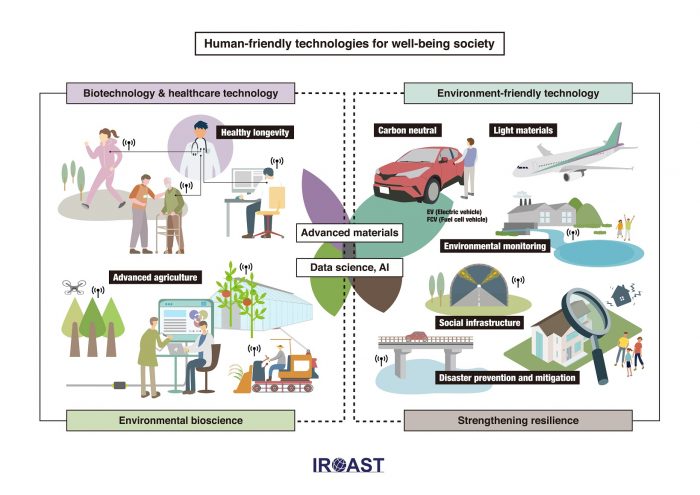- HOME
- ABOUT IROAST
- Overview
ABOUT IROAST
Overview
The International Advanced Science and Technology Research Organization (IROAST) was established in April 2016 to enhance international research capabilities in the natural science fields of the university. In collaboration with the university's research organizations in the natural sciences, IROAST has achieved many outstanding results by promoting international joint research with world-class universities and research institutions as well as launching cross-disciplinary research projects, such as medical-scientific collaborations. In addition, we invite outstanding researchers, and we are working to improve our international recognition by holding international symposiums and publishing the results of their research in international co-authored papers.
Furthermore, we are working to nurture internationally competitive researchers who can work at the forefront of global research by utilizing a tenure-track system, supporting research expenses, sending young researchers abroad, and involving postdoctoral researchers and graduate students in international collaborative research networks. Through these efforts, we aim to develop world-class, one-of-a-kind research and lead the world toward a safe and sustainable future as a brain circulation center that attracts outstanding researchers from Japan and abroad.
Phase 1(2016-2021)
We have designated the four areas listed below as the priority research areas for Phase 1, a period of six years beginning from 2016. Our goals during this phase are to enhance our international competitiveness in terms of research by developing distinctive, leading-edge research projects, and to foster creative young researchers to serve as the driving force for international research based on our internationally superior research foundation.
Nano Material Science:Pulse power science and advanced metal materials.Graphene oxide non-sheets,hydrogen production catalysts,and innovative materials under etreme conditions,etc.
Green Energy:Development and utilization of renewable energy resources, biomass application,etc.
Environmental Science:Environmental assessment, analysis of climate change,protection of underground water and shallow sea areas,etc
Advanced Green Bio:Interdisciplinary research areas.e.g.drug delivery systems,environment-friendly pesticides,medical diagnosis with X-ray CT and IT,etc.
Environmental assessment, analysis of climate change,protection of underground water and shallow sea areas,etc.
Phase 2(2022- )
During Phase 2, beginning from 2022, we plan to further develop and enhance our projects as an international research hub for the natural sciences, and engage in international research activities focused on the science and technology needed to build a society that provides safety, security, and well-being, with the goal of realizing Society 5.0, which will support the next generation of natural sciences.
Science and Technology for Building a Well-being Society

- Human-friendly Technologies …Biotechnology & Healthcare Technology/Environment-friendly Technology/Environmental Bioscience
- Strengthening Resilience …Safe and Secure Society
- Advanced Materials
- Data Science, AI
Three Missions
The cultivation of talented young researchers to lead the future
Under our tenure-track system, we recognize and foster talented young researchers through an international open call for participants. During the tenure-track period, participants serve as Principal Investigators (PI) by personally leading international joint research projects, establish international joint research networks with overseas researchers and researchers in different fields, and enhance their skills in research and educational activities by participating in joint research projects with postdoctoral researchers and providing research guidance to graduate students. We are also working to foster young researchers with a high level of international competence via our “Program for International Joint Research Faculty Members”, through which we send young researchers overseas, as well as by aiding participants in submitting academic papers in English and offering internship programs to provide research guidance to graduate students and young researchers from overseas.
The establishment of strong international joint research networks and promotion of international joint research
In collaboration with research organizations in the natural sciences at the university, we promote international joint research with world-class universities and research institutions. We hire the world’s leading researchers as distinguished professors, and grant internationally renowned researchers the title of visiting professor or visiting associate professor, and we contribute to the promotion and development of the university’s research activities from an international perspective by engaging in joint research, holding international seminars, and providing intensive lectures for graduate students. In addition, with the aim of establishing academic, cutting-edge international joint research networks, we also promote joint research by aiding IROAST tenure-track faculty members, other Kumamoto University faculty members, distinguished professors and visiting professors in forming research units.
The development of leading, cutting-edge research projects through interdisciplinary integration
Research Clusters led by young researchers are attracting the attention of researchers in other fields due to research into the development of wearable sensors for monitoring cardiac functions as well as the multifaceted application of imagery in collaboration with universities and medical institutions in Singapore. In addition, in collaboration with researchers from Australia and South Korea, we advanced research into functional nanomaterials for efficient treatment of tumors, and published the co-authored findings in top-level international journals. Furthermore, joint research conducted by researchers affiliated with both organizations is now underway, including holding joint seminars with the International Research Center for Medical Sciences (IRCMS). We have also begun collaborations with the humanities and social sciences.

